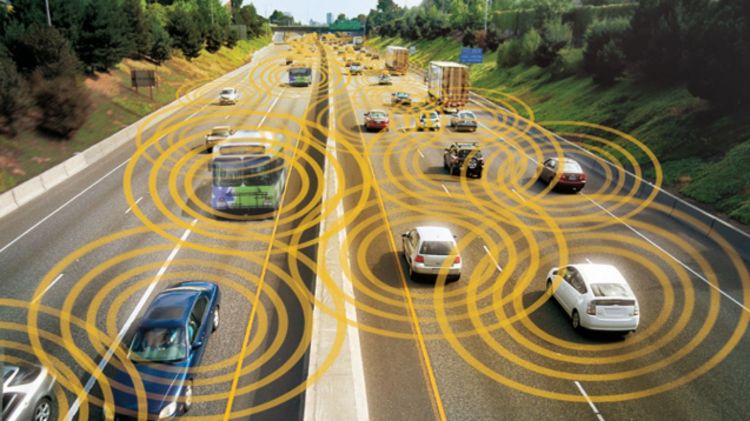We were driving at a normal speed in a parking lot in Las Vegas. A sensor in an old and boring minivan was connected to a receiver located on a traffic light, which was also in the trunk of another minivan. The driver was speeding along, glancing down at a display. The car slowed ever so slightly, but it wasn’t being driven autonomously. Instead, the driver was adjusting speed based on a display that estimated how long it would take to get to the light just as it turned green.
We sailed along as though it wasn’t odd to be driving this speed toward a red light. In most cases, human drivers see a red light and we naturally start slowing down. It became a little curious that we weren’t, almost like playing a game of chicken. Just in time, the light changed and we drove by without ever slowing down. It was a simple test, but it says almost everything you need to know about connected cars. They will do things humans would never do, but with clear benefits.
The company behind the test is called Savari, and they had outfitted the traffic light with their V2X (vehicle to infrastructure) equipment. (Curiously, it is in active use already in Las Vegas on public roads, but not for public use quite yet — that’s why we were in a parking lot.) According to company reps, when the car knows the light will change, there will be a 15 percent savings in fuel economy by maintaining speed. Humans don’t have enough data to make these decisions yet. With a normal car, a driver could make the adjustments; a self-driving car would do them automatically.
This is the exciting part about connected cars. A sensor can look in all directions at once, and an on-board computer can make calculations and connect to the cloud in a million ways as you drive. In terms of navigation, it could find road incidents hours away and adjust the route. There are clear benefits for safety, avoiding traffic jams, and ride-sharing.
In another test, Savari showed how connected cars will help deter accidents. We sped along toward another car, the same minivan. I was in the backseat, wondering how this might work. Just before we reached the intersection, a warning indicator appeared letting the driver know the other car was not going to stop. In another test, the driver braked for a car in front of us after a warning appeared. I’d never seen this before, mostly because a connected car infrastructure doesn’t really exist yet except in places like Ann Arbor, Michigan.
This technology for braking exists today in many higher-end cars using sensors that look for collisions, but the Savari demo showed how it works in a V2V situation. Also, the radars in many cars can be susceptible to fog and other weather conditions. I’ve tested several cars before that used radars for detection, and if there was too much ice on the car, the tech didn’t work.
You can make several interesting conclusions about connected cars and how they will help us. Let’s say most cars are connected to each other. A central server in the cloud could route cars constantly and improve traffic conditions. When any two cars meet at an intersection, both could adjust their speed to avoid a collision. Even pedestrians could transmit a signal. (We tested that scenario as well with a guy carrying a bag on the side of the road.) If someone steps in front of the car, you could get a warning, or a self-driving car could stop to avoid an accident.
Now throw in even more AI. In the future, cars equipped with machine learning could be constantly adjusting their speed. I envision being able to drive much faster in that scenario (as they already do on the safer, more restricted highways in Europe). I can envision fully automated roads built only for connected cars, all of them moving at optimal speeds to reach their destination. I can imagine a car traffic control center that is constantly processing data from these cars and constantly making improvements. I can envision a day when there are no more accidents at all and few fatalities, although there will always be extremely rare and unexpected events.
I liked what Savari is doing and their willingness to do an actual test that even made me squirm a little, even though I knew they’d done the test multiple times already in the same parking lot.
VentureBeat's mission is to be a digital town square for technical decision-makers to gain knowledge about transformative enterprise technology and transact. Learn More

